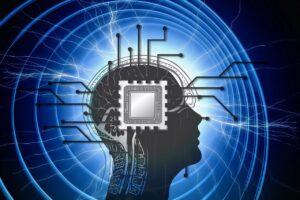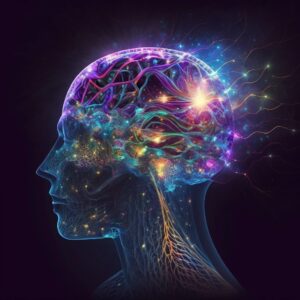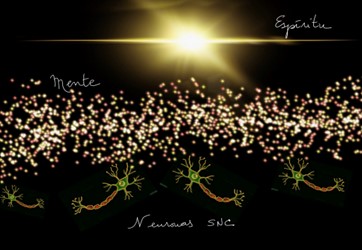© 2023 Helena Bañas
© 2023 International Urantia Association (IUA)
¶ The Neurophysiological Basis of Self-Control

This article deals with self-mastery, that ability that allows us to manage our emotions and instincts; to “respond” to them instead of “reacting,” which is key to “emotional intelligence,” a term popularized by the American psychologist, Daniel Goleman, in the 1990s.
One quote from The Urantia Book says that “emotional maturity is essential to self-control” (UB 52:6.6) and another is that “the manifestation of greatness on a world like Urantia is the exhibition of self-control” (UB 28:6.20). Thus, greatness would be synonymous with emotional maturity. A good start to achieving this goal is to know ourselves better. Understanding the functioning of our nervous system (NS) can help us to adjust our behavior.
The Urantia Book contains within its pages the true “keys” to achieve this self-mastery and contributes to science that which it cannot discover by itself; that which is invisible and enigmatic. It reveals to us who we really are.
By this, I mean that science attributes the ability for self-regulation, or self-control, to our brain, and establishes that it is the seat of our emotions, behavior and thoughts. But this runs into the classic mind-brain “problem,” or the difficult problem of consciousness, for which neuroscientists and philosophers cannot find a true explanation and end up calling it a “mystery.”
But are our thoughts and emotions a matter of brain biochemistry?
Many believe so. The age of neurocentrism began more than three decades ago with Thomas Willis, a pioneer of neuroscience, and continues to this day. But others, including Nikola Tesla, intuited that “the brain is only a receptor” and that “in the universe there is a nucleus from which we obtain knowledge, strength and inspiration.”
To address this issue, we begin by asking ourselves, what is life?
Life is really a process which takes place between the organism (selfhood) and its environment. (UB 112:1.13)
Initially, the most primitive organisms are totally dependent on their environment (UB 65:6.7), but as we evolve, we develop a physical tabernacle (brain) capable of hosting the mind and reacting intelligently to stimuli in the environment and later to stimuli originating within ourselves (UB 65:0.1). With evolution, this mind becomes increasingly dominant and can manipulate the environment itself (UB 65:6.9).
This dynamic relationship with the environment is very important because it will “shape” us, and can even change the structure of our brain, and even our genes.
So who are we really? What are the energies that compose us?
The Urantia Book informs us that space is not empty. It is bathed in three cosmic energies that come from the Deities of Paradise, subjected to incredible metamorphoses: physical energy, mind energy, and spiritual energy. These three are intimately correlated and are different realms of the same cosmic reality (UB 65:7.8) that God has encircuited throughout space (UB 3:2.4).
In our experience, these three energies are manifested in: 1) the physical body, whose most important part is the brain, 2) mind, and 3) the spirit that indwells us. Thus, we are the sum of these parts, and they constitute our self (individuality). Our personality unifies all these factors in order to relate to other cosmic realities (UB 112:1.18).
And another thing very important in relation to our individuality, which we are told about in Paper 112, is the relationship, or hierarchy, that these realities maintain among themselves. It tells us who (or what) really directs us. Our material body (brain) is subordinate to the mind (which is coordinating), and the mind is subordinate to the inner spiritual force, which is truly the one that “supercontrols,” the one who, potentially, directs (UB 112:2.1). Or, in other words, our body is “the physical repercussion of the creative action of the mind-spirit” (UB 42:12.14). Therefore, the brain reacts but cannot direct our lives.
Hence the revelators consider us to be a potential spirit that has a body, not the other way around (UB 42:12.12). And this is so because our goal is spiritual, since God is spirit and we are his offspring, his children.
But before talking about the brain, we have to talk about what the mind is, what consciousness is. And we already know that it is a type of energy that is neither physical nor spiritual, it is not visible. Here’s an enlightening quote:
Mind. The thinking, perceiving, and feeling mechanism of the human organism. The total conscious and unconscious experience. The intelligence associated with the emotional life reaching upward through worship and wisdom to the spirit level. (UB 0:5.8, emphasis added).
It would therefore be in the mind (not the brain) where ideas and feelings are generated and where we perceive through our senses. It is the seat of rational and emotional intelligence. And the NS is indispensable to capture and process external and internal stimuli, to bring them to the mind, and then make it possible to express the response of our mind-personality.
Cosmic mind proceeds from the Infinite Spirit and is given to us through the Divine Minister of the local universe as an impersonal portion in the form of an individualized circuit, which is separate from the undifferentiated mental circuits of this Spirit (UB 9:5.4).

An important point is that mind is not only an energy system but also entails the presence and activity of a living ministry (UB 42:10.7), the ministry of the Mother Spirit who exercises it through her “children,” the seven adjutant mind-spirits (UB 42:10.7). These spirits are also circuits that overlap with parts of the mechanical or unteachable mind. They use those regions of our brain necessary to exercise their function as “mediators.” On them our evolution depends (UB 65:6.10).
And angels are proof that the physical brain is not necessary for emotions, for they do not have a material body and yet they share all our feelings and emotions except sensual ones (UB 38:2.1).
And here are some defining (paraphrased) quotes of what the mind is:
- It is the mediator between material things and spiritual realities (UB 160:4.9)
- It is a mental gift that enables us to think and endows us with consciousness, even in the absence of personality (UB 9:6.3).
- Physical stimuli from the environment (external) reach the mind through our body’s nervous system (UB 108:6.4).
- The mind provides the ability to respond to the environment, to learn and remember. These are attributes of the mind, not the brain, because:
The laws of physics are not responsive to training; they are immutable and unchanging. The reactions of chemistry are not modified by education; they are uniform and dependable. Aside from the presence of the Unqualified Absolute, electrical and chemical reactions are predictable. But mind can profit from experience, can learn from reactive habits of behavior in response to repetition of stimuli. (UB 65:6.8).
This opens a huge door of opportunity in education and psychology. We are told by the revelators that mind can innately recognize, thanks to personality and spiritual ministry, and respond to the three basic realities of the cosmos (UB 16:6.5): 1) reality related to physical senses, causality, scientific realm, 2) duty, the realm of morality, and 3) worship, the spiritual realm of reality, the highest insight.
Personality, that divine gift without which our human mind cannot be conceived, would be that quality in which resides self-awareness and the capacity for choice, our free will. It is a key piece for our self-control.
It is our personality that decides to submit to the “supercontrol” of the spirit or to follow the hereditary “animal” impulses of the brain. This is our human paradox (UB 111:6.2). And the mind would be the arena of this choice, almost the only thing subject to the will of our personality (UB 111:1.5). It has been placed in our hands, subject to our own decisions, and it is through it that we live or die.
It is this creative inner world that we can really change by choosing whether it will be spontaneous or controlled (UB 111:4.9), since the environment itself cannot be changed (UB 111:4.8). The fact that we have personality implies that we can choose not to be slaves to our passions, but architects of our own eternal destiny (UB 103:5.10).
And it is the presence of these divine gifts that explains why consciousness is an enigma for scientists and why it is not within the reach of their methods of analysis. However, in recent decades, science has delved much into the knowledge of the brain, mainly due to novel methods of neuroimaging, such as functional nuclear magnetic resonance.
The brain is the product of animal physical evolution and is, therefore, subject to genetic inheritance. It is a product of the creativity of the spiritual beings responsible for our biological evolution. In Paper UB 42:12.11, we are told that “The liaison of the cosmic mind and the ministry of the adjutant mind-spirits evolve a suitable physical tabernacle for the evolving human being.”
Mind energy is fully rooted in our brain (UB 9:5.5) which, with its associated NS, would have an innate capacity to respond to mind ministry, just as the mind has a certain capacity to be guided by the spirit (UB 65:6.10). This is how our mind acts as a perfect mediator between these two universal opposites (UB 12:8.13).

And it is the presence of these divine gifts within us and their perfect integration with our electrochemical brain that is responsible for the inability of scientists to discern what the mind is, observing only a seemingly biological and natural reaction (UB 65:7.2).
And since the brain is the last link on which these gifts act—mind, spirit, and personality (UB 16:8.2), they are all going to be limited, in some way, by this inherited brain capacity (impacting both our intellectual capacity and our spiritual progress) (UB 58:6.7 and UB 65:8.4).
To fulfill its function, the brain must be tremendously complex. It’s said to be the most perfect machine that exists, leaving neuroscience much to discover. It can be studied in many ways, either based on its anatomical regions, or from a functional point of view.
The cerebellum and stem are parts of the most primitive brain, also called the “reptilian” brain, which is responsible for managing our instincts. Its function is pure survival.
Next is the limbic system, also known as the “emotional brain” or “chemical brain,” which is responsible for processing our emotions, and is also vital in the homeostasis of our body and memory. It’s the place of impulsivity.
Finally, the cerebral cortex or neocortex, the most recent part of the brain to evolve, is activated to perform the higher functions of which we are aware. It is our “thinking” brain. The Urantia Book reveals that we are two-brained creatures based on this dual cortex: “the two-hemisphere type of the Urantian cerebral cortex” (UB 49:5.14).
This cortex is divided into different lobes from the anatomical point of view, each with specific functions. The most important in our emotional control is the frontal lobe. It is responsible for complex cognitive processes, the so-called executive functions. That is, it allows us to choose, plan and make voluntary and conscious decisions.
The orbitofrontal cortex, which is part of the prefrontal cortex, is involved in socio-emotional processing and control through its connections with the amygdala. It constitutes a kind of modulator of the responses provided by the amygdala. This is the physiological core of emotional intelligence according to Goleman, or the center of management between thoughts and feelings.
These brain structures are the ones that react to mental ministry, according to the circumstances of our life, and will motivate a response or behavior. And this reaction is facilitated by the functional unit of the brain—the neuron, which is the cell responsible for transmitting and processing information throughout the NS. It is characterized by its ability to be excited electrically and chemically. It consists of a body, an axon, and dendrites that serve to transmit information between neurons through a mechanism called synapses, thereby releasing neurotransmitters that will “bathe” our brain of all kinds of sensations.
A neuron has a peculiar shape, a suitable design to receive the impulse of mental energy, and thus be electrically activated to transmit information at full speed to those regions of the body that must react to that impulse.

There are more than 100 billion of them, each capable of thousands of connections, forming roads, circuits, or neural networks. Every time we learn something, new connections, new networks are produced. The complexity of these would explain the great diversity of our characters and behaviors. The more we go through new paths (repetitions), the more habits we pick up and the faster the information is transmitted.
Researchers believed that dead neurons could no longer regenerate, but Ramón y Cajal, a Spanish neuroscientist in the early 20th century, sensed that, in the future, this could change. And it really has. Recent experiments have shown regeneration in neurogenic niches in certain areas of the brain, such as the hippocampus. This regenerative capacity is called neurogenesis and is key in neural plasticity or neuroplasticity, the amazing ability of the NS to adapt and react to the ever-changing environment, modifying its physical structure and functionality by means of synaptic strength, the creation of new connections, and the formation of new neural networks.
But in order to create new neural networks, experiments by the American neuroscientist, Michael Merzenich, show that repetitions are not enough; that high doses of concentrated attention are also necessary. Thus, experience (our choices and thoughts) plus attention cause changes in the brain. The brain, therefore, can also be modified from training, and this is very hopeful for medicine.
¶ The Limbic System
The limbic system is that part of our brain that regulates and expresses our emotions. Scientists disagree on how many brain structures form part of this system. But the most important are: the amygdala, hippocampus, thalamus, hypothalamus, pituitary and cingulate cortex.
Particularly important in the expression of emotions is the amygdala, shaped like an almond. There are two of these and they are located deep in the temporal lobes. They are highly complex and maintain multiple connections with other areas, especially the thalamus and prefrontal cortex.
It is important to highlight the discoveries of the neuroscientist, Joseph LeDoux. He revealed much of the nerve circuitry of the limbic system, including the neural basis of human emotional reactions, which he explained as neural branching between the thalamus and the amygdala.
The functioning of the emotional brain begins with a relevant external or internal sensory stimulus that reaches the thalamus where it is reconverted into a brain stimulus understood by neural cells. After the thalamus, most of the stimulus passes to the area of the neocortex specializing in the evaluation of information (e.g., visual cortex in the case of a stimulus from the eye) and in designing and issuing a response, sending the necessary orders to the necessary organs.
In the event that the information requires an emotional response, the neocortex will send the signal to the amygdala, which then orders the appropriate emotional response. This response involves the hypothalamus, nerves, motor system and hormonal system, causing reactions in different parts of the body, such as the secretion of hormones or the movement of a hand.
But not all information goes to the neocortex; a small portion goes directly to the amygdala by a shorter route. This allows a faster response if necessary, an essential time factor if we consider the need for survival of an evolutionary species. So there are times when emotion takes precedence over reason.
In the case of anger or intense emotions, the amygdala “steals” the activation of other areas such as the cortex, dominating the subject’s behavior and turning off the area that makes us more rational, more human, leading to the phenomenon known as an amygdala hijack. “Anger depletes the health, debases the mind, and handicaps the spirit teacher of man’s soul” (UB 149:4.2).
In a situation of normal stress, the activation of the amygdala entails activation of the HPA (hypothalamic-pituitary-adrenal) axis. The result is the secretion by the adrenal gland of adrenaline and corticosteroids, as well as the activation of the autonomic NS and our defenses, necessary to give a rapid response to emergencies in our environment. Once the event is over, our body returns to its normal balance, a process facilitated by the limbic system and its connections.
In case the reaction persists, such as a continuation of adverse life events, loneliness, trauma, or abuse, a chronic process of emotional distress occurs. This causes either excessive use or poor management of hormones, corticosteroids, and catecholamines by the complex neuroendocrine immune network, resulting in a negative impact on the nervous, endocrine, and immune systems. And the end result of our lack of self-control over external or internal stressors, is a pro-inflammatory physical state (hypercortisolism).
Glucocorticoids produce genomic and non-genomic effects in the brain and body through multiple sites and pathways (NF-kbeta, TNFa), causing a broad spectrum of diseases, such as depression, diabetes, immunoallergic disorders, and cancer, all of which are the leading causes of disability and mortality worldwide.
This state (loss of self-control) is particularly neurotoxic, causing atrophy of the hippocampus and prefrontal cortex as well as hypertrophy of the amygdala, both of which weaken cognitive function and increase emotional hyperactivity. This dysregulation has a very negative impact on neurogenesis and neuroplasticity and can modify our genome through epigenetic modifications.
Epigenetics is another adaptive molecular device that responds to environmental needs by regulating gene expression, and is very important for neural plasticity. It refers to the changes that occur in our DNA without altering its sequence or “the mechanisms that allow programming a genome in many ways.” An example is the cells of our body, each with its own identity and function.
The three main epigenetic modifications are: DNA methylation, histone modification and micro RNA. The result is that genes can be turned on or off (in a reversible or irreversible way).
Ultimately, our way of living will determine what we will be and these changes can be transmitted to our offspring. This is noted in the quote:
…when anxiety becomes actually painful, it inhibits activity and unfailingly institutes evolutionary changes and biologic adaptations. Pain and suffering are essential to progressive evolution. (UB 86:2.1, emphasis added)
This adaptation is a dynamic relationship in which neuroplasticity, epigenetics, and neurogenesis are totally interrelated and subject to the attitude of our personality—to our choices (both positive and negative). Although our biology is designed to adapt positively to the ever-changing environment, when the response is disproportionate and not under our mental control, it can make us suffer a lot, hinder our relationships, lead to illness and, ultimately, fail us in the art of living.
But… the flip side is that we can change those neural pathways and decide to “play a symphony!” We can decide to be the conductor who uses the plastic capacity of the body with a harmonious result, like a melody, so that our brain releases neurotransmitters such as endorphins, serotonin, oxytocin, and dopamine; what scientists call “the quartet of happiness.” Let’s think of when we are in love…
Jesus required his followers to react positively and aggressively to every life situation. (UB 159:5.9, 1770.1)
But… how? Can we achieve this transformation only with an act of our will, desiring only to be optimistic?
Many say it is impossible because we are genetically determined, but Jesus told us that although our inherited impulses cannot be modified, our emotional reactions to them can; we can improve our character and our moral nature when our emotions are integrated and coordinated into a unified personality (UB 140:4.8, UB 118:8.2). And this should be the goal of education: to assist in the development of a balanced personality (UB 195:10.17).
The key to achieving this is not through the old way of a self-denial, “The dead theory of even the highest religious doctrines is powerless to transform human character or to control mortal behavior” (UB 34:6.6), but instead, through the new way of Jesus, the first thing is to be transformed by the spirit. In this kingdom, we become “new creatures” (UB 143:2.3).
The secret of our self-control is the inner spirit that indwells us, the Spirit of the Father, which always acts out of love and sets us free (UB 143:2.7). And this spirit possesses no special mechanism for expressing itself except through the mind; and it would do so through the highest thoughts, not emotions. “…strong feelings of emotion are not equivalent to the leadings of the divine spirit” (UB 159:3.6). This quote implies that self-control works in our cortex to make our “spiritual duplicate,” not in the emotional brain.
And today, Jesus (his Spirit) continues to transform us. “He unifies life, ennobles character…” because “He enters the human mind to elevate, transform, and transfigure it” (UB 100:7.18, emphasis added).
In worship, the mind gets in touch with the spirit (UB 160:3.1) and spiritual energy flows to make those transformations in us. It’s possible that the adjutant mind-spirit of worship may “activate” our brain endocrine glands (pituitary and pineal) to release the neurotransmitters and hormones that influence our spiritual receptivity to produce the experience of peace and well-being (UB 49:5.19).
Neither psychology nor idealism is comparable to the effect this spiritual energy has on us. And repeating the practice of worship is essential for our reactions to become habits and to develop a kind of spiritual conditioned reflex (UB 100:1.8) that makes our character grow “like a mustard seed” (UB 140:8.27). It also makes it easier for us to progressively reach the psychic circles of our personality (UB 110:6.6) so that every day we live, we find it easier to do what is right (UB 156:5.13).

It will become easier and easier to gain self-control, because pathways (neural networks) that transform our plastic brain are being carved out. And that is what neuroscience shows today: meditation can change certain areas of the brain and even the expression of inflammatory and epigenetic-modulating genes, favoring our resilience, our health and longevity.
These wonderful transformations of human character that “the laws of physiology, psychology, and sociology” cannot explain (UB 102:2.3), soon manifest as the fruits of the spirit which are: “love, joy, peace, patience, kindness, goodness, faith, meekness, and temperance.” These fruits are the most we can attain in this life—“true self-mastery” (UB 143:2.8). That’s why Jesus never tired of proclaiming: “Seek first the kingdom…” (UB 140:1.5). And when we find it, problems do not disappear but instead “dissolve” (UB 196:3.1). We begin to feel what true freedom is, “the fruit of self-control” (UB 54:1.6).
Unifying our physical, mental, and spiritual systems is how our personality achieves high levels of life, well-being, true happiness, and health (UB 100:4.3).
This is also the purpose of cosmic evolution, the unification of personality through the increasing dominion of the spirit, for this personality (human or superhuman) is characterized by an inherent cosmic quality that is the evolution of dominance, “the expansion of the control of both itself and its environment” (UB 112:2.15) needed to achieve that unity which is God.
And in all living beings there is an “insatiable craving for the attainment of ever-increasing perfection of environmental adjustment, organismal adaptation, and augmented life realization” (UB 65:6.2) to respond to our Father’s command to “be you perfect, even as I am perfect” (UB 1:0.3). And this goal is “wholly compatible with a lighthearted and joyous life” (UB 110:3.4) because “this new gospel of the kingdom of Jesus renders a great service to the art of living in that it supplies a new and richer incentive for higher living” (UB 160:3.5).

We can change! Even if we have to try many times. And certain seraphim will someday ask: “If you fail, will you rise indomitable to try anew?” From them we will learn “to accept challenges without complaint and to face difficulties and uncertainties without fear” (UB 48:6.35). “Only man can attain the art of living” (UB 160:1.5, emphasis added). And perhaps this art could produce evolutionary and adaptive changes in our genes that take us to the longed-for eras of light and life.
Let us make Jesus the “Daniel Goleman” of the future. In Jesus’ message, resides the true seed of emotional intelligence. His religion, “in this age of scientific minds and materialistic tendencies, in this gigantic struggle between the secular and the spiritual, will eventually triumph” (UB 195:4.5).
¶ BIBLIOGRAPHY
Daniel Goleman. Emotional intelligence. (1996)
Daniel Goleman. “Altered features. Science reveals how meditation transforms the mind, brain, and body.”
Vladimir V. Kosonogov et al. “A review of neurophysiological and genetic correlates of emotional intelligence.” International Journal of Cognitive Research in Science, Engineering and Education 7.1 (2019): 137. https://doi.org/10.5937/ijcrsee1901137K
Bruce S. McEwen. Neurobiological and systemic effects of chronic stress. https://doi.org/10.1177%2F2470547017692328
Anna Giulia Bottaccioli. “Bidirectional relationship between psychic life and the biological molecule: pathways, mechanisms and consequences for medical and psychological sciences: a narrative review.” Int. J. Mol. Sci. 2022, 23(7), 3932; https://doi.org/10.3390/ijms23073932
N.N. Dasanayaka et al. “Impact of Meditation-Based Lifestyle Practices on Mindfulness, Wellbeing, and Plasma Telomerase Levels: A Case-Control Study.” Front. Psychol., 04 March 2022; https://doi.org/10.3389/fpsyg.2022.846085
Alvarez-Lopez MJ, Conklin QA, Cosín-Tomás M, Shields GS, King BG, Zanesco AP, Kaliman P, Saron CD. “Changes in the expression of inflammatory and epigenetic-modulatory genes after an intensive meditation retreat.” Buy Psychoneuroendocrinol. 2022 Jun 23;11:100152. https://www.sciencedirect.com/science/article/pii/S2666497622000431?via%3Dihub
https://neurofeedback-neuroconsult.es/ncl/iemo/inteligencia-emocional.htm
https://www.investigacionyciencia.es/files/23528.pdf